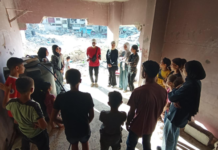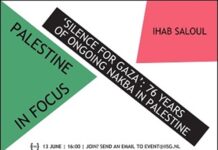Haniya Albaioumy
The Guardian / July 11, 2024
Who knows what we will discover beneath the 37m tons of rubble? Yet this will be the most vital work I have ever done
Amid the many horrors unfolding in my Gaza homeland, there is one that, for now, is hidden but threatens to blight hopes for recovery long after the bombs have stopped falling.
Gaza is one of the most densely populated places on Earth. And, tragically, it could now be one of the most densely contaminated in terms of unexploded munitions. This is a deadly legacy that will claim lives and hamper attempts at reconstruction for years to come.
I know this, because in my role as an emergency response manager for Mines Advisory Group (MAG), I will be one of those tasked with assisting colleagues as they clear the unexploded bombs left behind. Our daily work requires sifting through the rubble and detritus of war in heavy body armour, trying to map a way forward from the destruction and devastation.
I am from Gaza City, so I have a special personal interest in returning my home to some kind of normality: a place where children can play at the seaside and their parents can go about their normal lives without fear of an unexploded bomb going off nearby.
Hundreds of thousands of missiles, grenades, shells, mortars and other weapons have been expended in Gaza since 7 October. A significant proportion of those weapons will have failed to explode and could be buried, lodged in the rubble or lying on the surface. Landmine and explosive ordnance experts like us have to go into war zones after the dust has settled and find each and every one of these potentially lethal items, making them safe. In Gaza, the painstaking and dangerous reconstruction operation could, according to the UN Development Program, cost some $40bn (£32bn) and take more than a decade to complete.
The precise scale of the challenge will only be known when safe access allows a proper survey, but the nature of it will certainly be unique. To compare with recent urban conflicts in which my colleagues have extensive experience, the contamination in Gaza will almost certainly be more complex than that which we saw in Mosul, Iraq, or Raqqa in northern Syria, where the battle against Islamic State left widespread devastation that is still visible today. These places were ravaged by the use of heavy weapons, but the sheer scale of the destruction in Gaza (which is twice the size of Mosul) and the dense nature of Gaza’s urban environment will make clearance here extremely challenging.
The scale of the task is made worse by the sheer variety of weapons deployed – from precision-guided missiles to artillery fire and grenades. There is an estimated 37m tons of rubble through which experts will have to sift to detonate explosives; and then there are the airdropped bombs that could be buried as deeply as 14 metres under the surface. Each will require a different approach, with some being detonated in place and others requiring the removal of complex and sensitive fuses by highly trained explosive ordnance experts.
Such clearance is expensive and time-consuming. And it has intrinsic hazards. In Gaza, we know there will be asbestos and chemical hazards, and that locations such as hospitals will present additional biological or radiological hazards arising from contaminated equipment and X-ray facilities. Tragically, the explosive ordnance experts will probably also have to face the distressing task of handling human remains.
As a new government in the UK has started to think about what will be required on “day one” after the war, and with competing geopolitical priorities globally, states must reckon with how they begin to deal with the aftermath of this conflict. Because the sooner we can survey, prioritize and commence the dangerous and difficult job of clearance, the sooner we can enable safe passage for humanitarian relief and the reconstruction of essential infrastructure.
For me, this is personal: I left Gaza just three months ago but my family remain there, sheltering from the missiles in makeshift accommodation along with hundreds of thousands of others in Khan Younis. I worry about what the future holds for my family, for my nephews and nieces. When will they have a home again? When will they have a school to attend? When will they be able to walk without fear? I think constantly about my loved ones’ safety and our impatient hopes for peace.
As a professional who has worked in humanitarian mine action for the last decade, I also think of the concrete actions we need to take now to ensure the swiftest possible recovery for the Palestinian people in Gaza. Those steps are simple to define: a ceasefire that ends the killing and enables safe access; and for the international community to commit to and release funding as soon as possible.
The sooner Gaza can be made safe, the sooner we can rebuild our communityand the sooner we can begin to pick up the pieces of our shattered lives.
Haniya Albaioumy is a Gaza emergency response manager for the Mines Advisory Group












